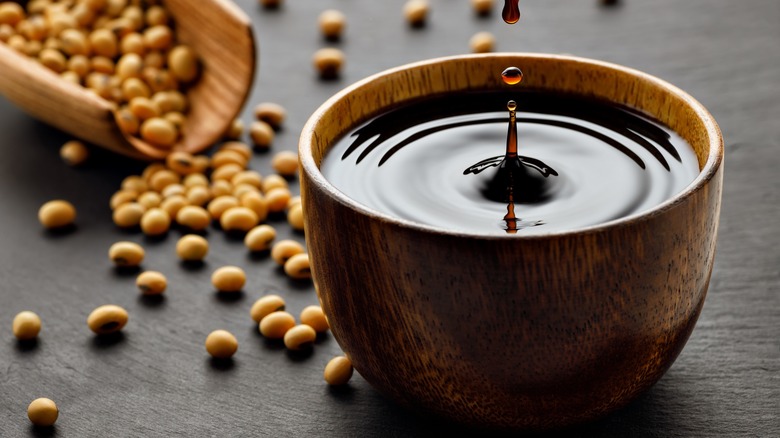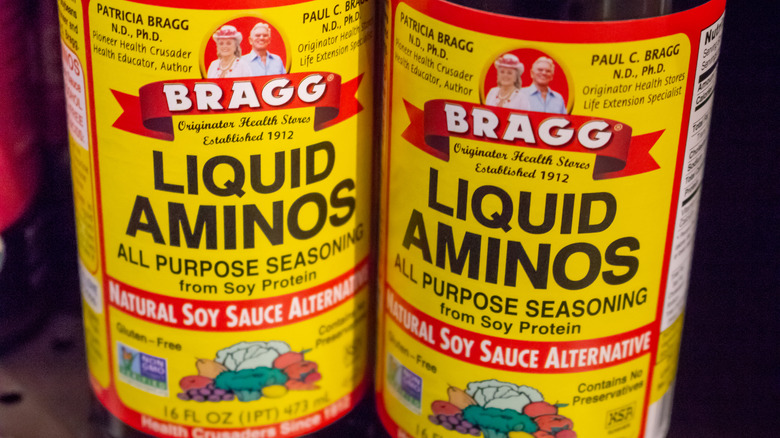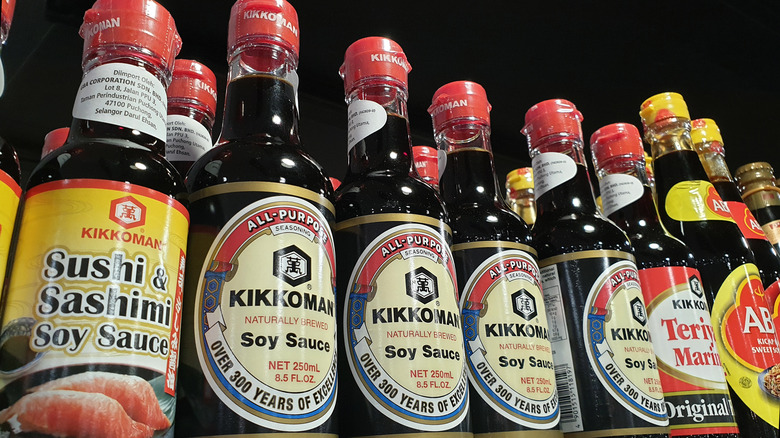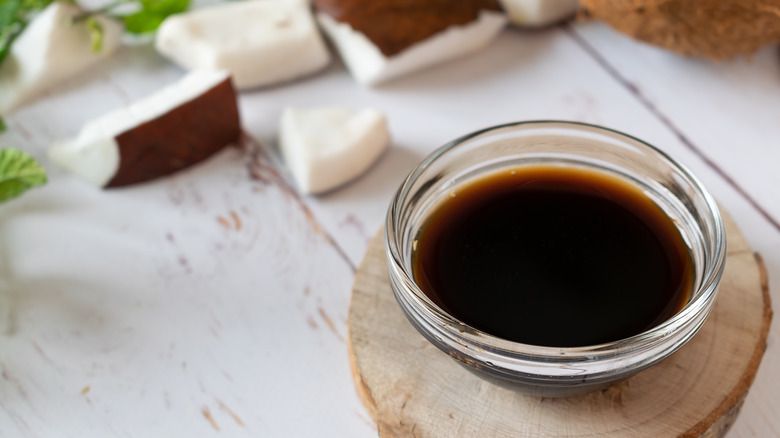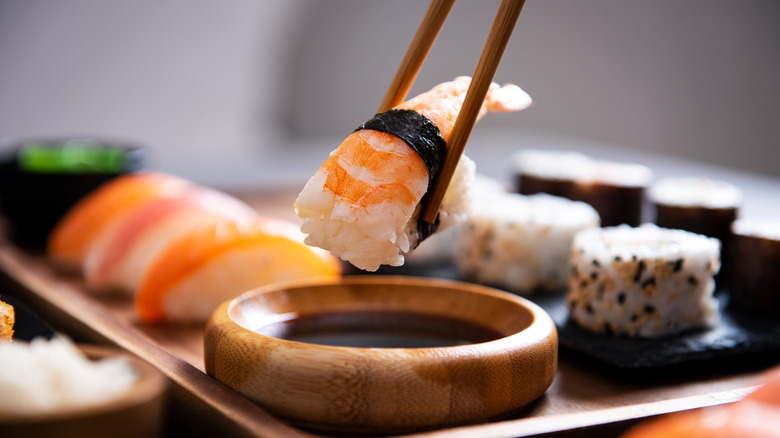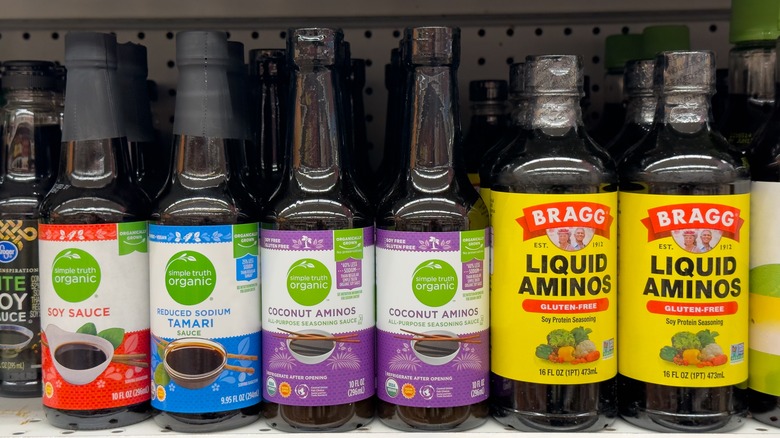The Soy Sauce Swap That's Packed With Flavor (And Still Vegan)
There are so many different diets nowadays, from paleo to keto to alkaline. Whether you're into the diet trends or not, finding healthier alternatives to pantry staples is an easy way to aid your fitness goals. Liquid aminos are one such alternative that have been slowly but steadily making their way into our kitchens, and for good reason. They're light on the palette but rich in flavor, making them highly versatile without being relegated to fluff.
Commonly used as a substitute for soy sauce, liquid aminos are great for cooking and dipping. They may sound like a dietary supplement, but they are a cooking ingredient through and through. If you've never tried them, they might seem a little intimidating, but don't worry — we're here to show you just how delicious and versatile they are when used as a cooking sauce. Once you try them, you may never go back to soy sauce again. Consider yourself warned.
What are liquid aminos?
Liquid aminos are soybean-based sauces used for cooking or as a condiment. Dark in color and full of amino acids, these super sauces can do it all. They're often added to stir-fries and other Asian recipes to tie the flavor together and help the ingredients cook. As a condiment, liquid aminos work as sushi dip or for adding body to a salad dressing.
Liquid aminos are marketed as a soy sauce replacement, and it's no wonder why. Liquid aminos have the same distinctive dark color as soy sauce, and they are swapped one for one in any recipe, making the transition between the two as easy as it gets. They're also very straightforward — their ingredient list is only two words long: soybeans and water. And despite their lack of preservatives, liquid aminos have a shelf life of three years.
Amino acids are the building blocks of proteins, so when you eat amino acids, you're giving your body the material it needs to create the tens of thousands of different proteins your body requires to function. There are 20 different amino acids your body needs, but nine of those are only available through your diet — the human body isn't capable of producing them itself. These nine amino acids are called essential amino acids, while the others are called non-essential. Te most common brand of liquid aminos — Bragg — has 16 amino acids, including eight of the essentials.
How are they made?
To make liquid aminos, the manufacturer makes hydrolyzed soybeans. Hydrolysis is a process whereby the soy protein is broken down into its constituent amino acids. This is done by covering soybeans in hydrochloric acid until the amino acids have been released. Sodium bicarbonate, commonly known as baking soda, is then added to neutralize the acids. Hydrochloric acid may sound scary, but it's perfectly safe once neutralized into salt and water. The final product is only hydrolyzed soybeans, water, and a decent amount of sodium. Though soybeans are the most common hydrolyzed vegetable protein, corn and wheat are also popular.
Due to the reasonably technical process of hydrolysis, it would be difficult to make liquid aminos at home. The process also creates some carcinogenic chemical byproducts — better to leave it to the professionals.
Liquid aminos vs. soy sauce
The most obvious difference is their ingredients. Liquid aminos are made from soybeans and water, while soy sauce is made from soybeans, salt, wheat, and water. That means soy sauce isn't gluten-free, while liquid aminos are. Soy sauce also contains all nine essential amino acids, while the most common liquid aminos brand — Bragg — is missing trpytophan.
The addition of salt to soy sauce also means it has a higher sodium content, so if you're looking to cut sodium out of your diet, switching to liquid aminos could be a good alternative. That said, liquid aminos do still have a relatively high sodium content. If you're struggling with sodium-related health issues like high blood pressure, bear in mind that liquid aminos aren't really a low-sodium option.
For anyone concerned with the inclusion of preservatives in their diet, another great thing about liquid aminos is that they have none. Soy sauce often contains sodium benzoate, a common food preservative that is considered safe — but which some people have an allergic reaction to. Although more research is needed, WebMD says sodium benzoate may also cause inflammation and has been shown to become carcinogenic when paired with vitamin C (or ascorbic acid).
Liquid aminos vs. coconut aminos
As you may have guessed, coconut aminos come from the coconut tree, but they're made from the sap of coconut flowers — not the fruit. Such products are sold as a healthy alternatives to soy sauce. Some companies, such as BMT Foods, claim their coconut nectar contains all nine essential amino acids and about 17 amino acids in total. This company in particular sources coconut nectar, coconut aminos, and coconut water, among other things.
Coconut aminos are great for people avoiding soy and sodium — they have less than half the sodium content of soy sauce and liquid aminos. They also have a thin consistency and light, sweet flavor, making them very similar to liquid aminos in terms of taste. That means you can substitute the three out for each other quite easily — though you shouldn't use coconut aminos in place of dark soy sauce as their consistency is too different.
What do they taste like?
Liquid aminos have a salty-sweet taste rich with umami. You likely wouldn't want to drink them on their own, but they can round out a dish quite well. You won't get as much saltiness as soy sauce, which is good if you want your liquid aminos to exist in the background. You also won't get the same savory richness that tamari offers, but having a more subtle cooking sauce is often precisely what you're looking for.
If you've ever had soy sauce, the taste is nearly identical — the subtle differences between any of these sauces aren't going to jar the taste buds. This is especially the case when using liquid aminos as a cooking sauce. But if you are using something like Bragg as a condiment or dipping sauce, the differences will stand out more. Soy sauce tends to punch you in the mouth with its salt-forward character, while liquid aminos will let the sandwich, sushi, or whatever the main thing is stand out more. They're more restrained and will add a little umami, a little sweetness, and a little salt.
How to cook with liquid aminos
If you know how to cook with soy sauce, you know how to cook with liquid aminos. If you don't know how to cook with soy sauce, it's used as a cooking sauce as part of a marinade or as the body of more complex sauces. Most commonly associated with Asian cuisine, liquid aminos can be used in stir fries and fried rice. As you are cooking the vegetables, pour a splash of liquid aminos in to give them some liquid and cook in instead of grilling on the stove. For marinades, use liquid aminos as the body and add spices like garlic, ginger, and paprika. Cover your meat in the marinade and let it rest for several hours. The meat will soak up the sauce, which makes a huge difference in flavor at the end.
Your options are limitless. If you want to add a little umami to a dish, just add a splash of liquid aminos and you've got yourself a full-bodied palate-pleaser. Don't be scared of liquid amino products, but don't add too much or your dish will come out tasting salty — a splash into risotto, soup, eggs, or roasted vegetables is enough.
Where to buy
Liquid aminos are easy to find if you aren't picky about the brand. For better or worse, most supermarkets only carry one brand: Bragg. If, for whatever reason, you are looking for a different brand, try health food stores. They will likely have more variety and may be more knowledgeable about what each brand excels at.
If you'd like to dive all the way in, the internet can be a great source of information. Any company producing liquid aminos will have their product available online. You can try buying them off Amazon, searching online stores, or looking through the catalog of nearby grocery stores.
If you're having trouble purchasing liquid aminos, you're likely looking in the wrong place. They are a widely available product and very recognizable. They aren't so obscure that your local grocery store won't recognize what you're talking about if you ask for directions to which aisle they're in. Some stores may have it near the soy sauces in the international food aisle, others may have it in the health aisle or near the spices and vinegar — but it's very likely somewhere.
Nutritional information about liquid aminos
Each brand of liquid aminos will have slightly different nutrition, but we're going to look at Bragg Liquid Aminos because it is the most widely available. For 1 tablespoon of liquid aminos, you're only getting 9.8 calories, so if you're counting calories, this is an easy win. You'll get a nice boost of 1.8 grams of protein as well.
The downside of liquid aminos is sodium content. Yes, there's less sodium here than in soy sauce, but you're still getting 687 milligrams, which is a chunky 29% of your daily value. For people with high blood pressure or heart problems, adding liquid aminos to your diet could have negative health consequences. It's better than soy sauce in this regard, but it's still worth paying attention to.
As was mentioned before, the primary selling point of liquid aminos is the amino acids. Bragg boasts 16 essential and non-essential amino acids — critical pieces of a well-balanced diet.
